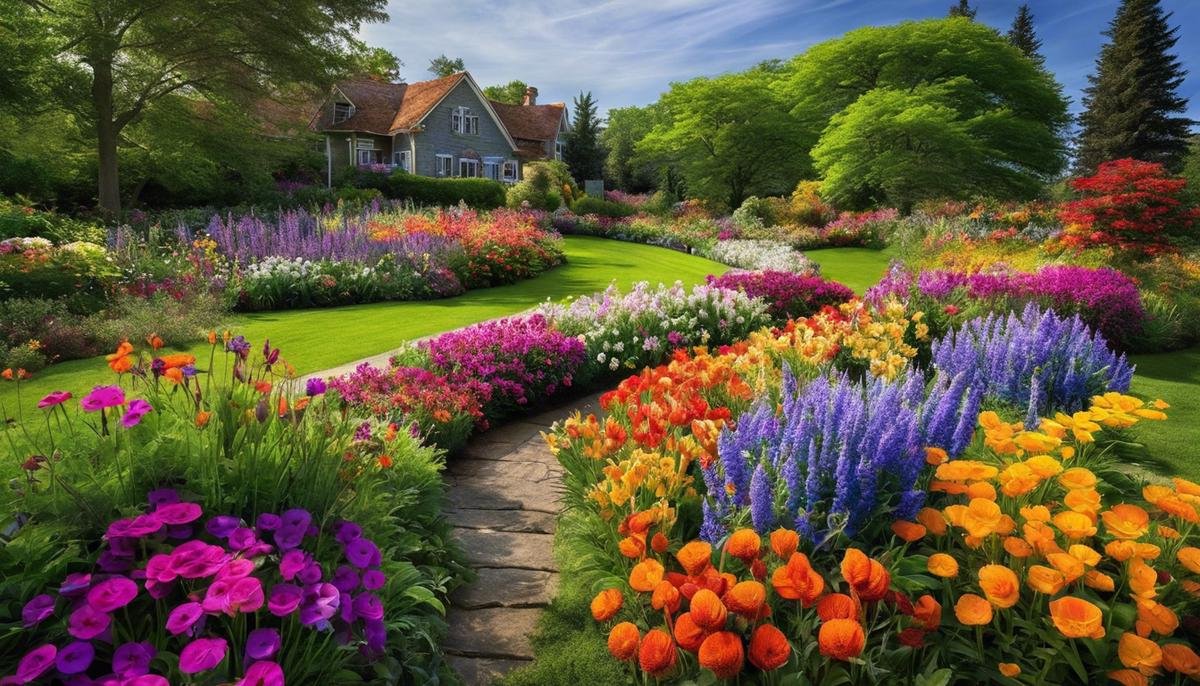Imagining a garden filled with vibrant colors and brimming with life evokes a sense of calm and delight inherent to the beauty of nature. As the frost of winter recedes and the heralds of spring unfold, we witness a remarkable renaissance of life in the form of blooming perennial flowers. These vibrant plants, known for their hardiness and resilience, do more than just grace our gardens. They remind us of the cyclical rhythm of life, reblooming year after year, adding rhythm and spectacle to our landscapes. In our exploration into the enamoring world of perennials, we’ll understand their biological intricacies, the sustainable aspects related to their growth, and even dive into some of the best varieties to choose for springtime splendor.
Understanding Perennial Flowers
Headline:
Blooming Marvels: Why Perennial Flowers are a Fantastic Spring Sensation
Spring is a season of rebirth, growth, and color. The days get longer, the birds come back, but what really announces the arrival of this vibrant season? It’s the appearance of perennial flowers! Perennials, fondly referred to as ‘seasoned warriors’ by gardening enthusiasts, are exceptional plants that bloom year after year. Immensely resilient, perennial flowers can weather harsh winter frost and emerge even more vibrant when spring arrives!
One aspect that makes perennial flowers unique is their lifespan. Unlike annuals and biennials, perennials exist for more than two years; over time, they develop a mature root system. During winter, the plant hibernates, its energy retreats into the roots waiting for the warmth of spring to draw it back up. This persistent root system allows them to emerge bigger and brighter each spring.
Perennials are a joy to behold when they bloom in springtime. Their brighter colors and larger flowers capture the essence of nature’s awakening. One of the most appreciated spring perennials is the Peony, known for its voluminous, vibrant blooms and rich color palette. It’s almost as if these enduring flowers have been storing the brightness of the previous year’s sun to explode in color and bring life to the spring garden.
Beyond their ability to brighten up garden spaces, perennials are loved for their hardiness. Most varieties can tolerate a wide range of soil conditions – enriched soils to the nutrient-poor, well-drained to those that retain water, sunny locales to the more shady corners. As the gardener’s faithful ally, these plants know how to survive, adapt, and bloom ceaselessly, year after year.
A significant benefit of choosing perennials for a spring garden is their eco-friendliness. These plants build a robust micro-ecosystem as they continue to grow for many years in the same spot. Local fauna become accustomed to their nectar, leaves, and even their stems. Butterflies, bees, and other beneficial insects are attracted to these consistent sources of food, thereby supporting local biodiversity.
Also worthy of mention is the variety among perennials- there is an abundant choice to match any gardener’s preference. From traditional roses and lilies to exotic crocuses and bleeding hearts, there are perennials for every garden, theme, and personality.
When considering a spring garden, daffodils and tulips might, understandably, be the first thought. But do ponder upon perennial flowers. Their hardy nature, vibrant and generous blooms, ease of care, and powerful contribution to the ecosystem make them a perfect inclusion in any spring garden.
So, as the frost begins to thaw, the birds start to chirp, and the leaves sprout anew, let’s celebrate the humble, resilient perennial flowers. They carry within them the strength of survival and the promise of a splendid bloom, making spring all the more special!

Best Perennial Flowers for Spring Blooms
Springtime heralds the emergence of some truly phenomenal perennial flowers.
Characterized by their ability to return year after year, their blossoms offer a visual spectacle that can breathe life into any garden landscape. Let’s dive into the world of perennials and discover the top varieties that explode into bloom in the spring!
Undeniably, the Prima Donna Peony is a stunner. This beloved perennial commands attention with its lush pom-pom flowers which emerge in hues of pink and white. They offer a sweet fragrance that fills the air, making them a delightful sensory addition to the garden.
Hellebores, often referred to as “Lenten Roses”, are another remarkable variety. They challenge the mold by blooming in cooler temperatures, often as early as late winter. Their uniquely shaped petals range from delicate pinks to rugged purples, offering an impressive early splash of color to your spring garden.
Without a doubt, the Bleeding Heart is a dramatic addition. Their heart-shaped blooms and fern-like foliage fill gardens with charm and whimsy. What’s amazing is their adaptability – thriving in shadier spaces where most other perennials might struggle, showing off their vibrant pink and white blossoms to full effect.
The Spring-blooming Phlox is a fragrant wonder and a true survivor, often unfazed by harsh weather conditions. Available in a myriad of colors, they can be the perfect solution for difficult-to-grow areas as they are low-maintenance and offer vibrant color in late spring.
Irises are a must-have too; their elegant flowers, often with intricate designs and striking color schemes, are a favorite among gardeners. Apart from their undeniable beauty, they are loved for their hardy nature and bloom profusely throughout the spring season.
No list would be complete without the charming and cheerful Daffodils. Native to the Mediterranean, these harbingers of spring bloom even before the last winter snow has melted. Their sunny yellow petals and trumpet-shaped flowers are a sure sign that warmer weather is on its way.
Finally, there’s the Columbine, known for its unique, spurred blooms. This variety thrives in nearly any soil type, with blooms in shades of pink, white and purple. These flowers are superb for attracting hummingbirds and butterflies, making your garden an oasis for local wildlife.
So there you have it – a vibrant palette of perennial flowers ready to make their grand appearance in the spring. Varying in colors, shapes, and sizes these remarkable plants offer an unrivaled combination of aesthetics, hardiness, and adaptability. Whether you’re a novice gardener or a seasoned horticulturalist, incorporating these beloved perennials into your spring garden design will assuredly result in a dramatic and beautiful landscape. Here’s to a garden bursting with life and color – all through the spring season!

Planting and caring for Spring Perennials
Heading into the heart of the matter, how can anyone effectively plant and care for these magnificent gems of nature? Well, there’s no one-size-fits-all answer here, every perennial flower requires a slightly different touch. However, there are some universal methods and practices that can maximize the floral display of your garden.
Planting spring-blooming perennials doesn’t require people to have the green thumbs of an expert botanist. It’s a process that calls for preparation, patience, and a love for nature. In the planting stage, select an appropriate site factoring in the sunlight needs of the plants. Sunlight plays a vital role in photosynthesis, which is integral for the plant’s growth and flower production. Therefore, place sunlight-loving flora like the flamboyant Prima Donna Peony in an area that receives hours of unobstructed light.
Moreover, improving the soil quality can help in boosting the plants’ growth rate. Some gardeners contend that a mix of compost and garden soil offers the best results. The compost enriches the soil, providing the essential nutrients for the perennial plants. Remember to place the plants at a proper depth in the soil. Planting too deep can suffocate the root system and impede growth.
Properly spacing the plants is another crucial aspect. Giving them ample space helps in air circulation and prevents the spread of disease. Plants like the graceful Irises and delicate Columbines need elbow room to thrive and spread their beauty unobstructed.
Watering the plants properly is the next crucial step. Every plant has different watering needs. For plants like Daffodils, which love water, regular watering is essential. On the other hand, Hellebores do well even in drier conditions. Being aware of these distinctions can help one create an effective watering schedule.
Consistent care also involves monitoring for pests and disease. Employing methods like soil rotation and the use of natural pesticides can largely contribute to a robust and healthy garden. Also, ensuring that the plants continue to receive proper amounts of sunlight, water, and soil nutrients is paramount to their growth and bloom.
The joy of caring for perennials isn’t restricted to just their planting. Keeping the garden environment clean, trim, and orderly goes a long way in enjoying luscious blooms. Deadheading, a practice involving the removal of old, faded flowers, encourages further blooming.
In essence, planting and caring for perennial flowers are activities that demand attention, understanding, and a gentle hand, but the resulting display of colors and fragrances makes every sweat-bead worth it. Rejoice in the process, and your spring garden will be the talk of the town.

The joy of gardening is greatly enhanced when we get to witness the fruits of our labor with recurrent blooms each spring. By embracing the features and growing conditions of perennials, garden enthusiasts can create splendid landscapes that not only persevere through multiple seasons but also become a source of continual delight. Furthermore, with a good understanding of proper planting and maintenance routines, perennials continue to bless our gardens year after year, with minimal effort, while contributing to a greener and more sustainable environment. Thus, as admirers of nature and curators of beauty, let us partake in this gardening journey towards creating havens of perennial flowers that add color and joy to our lives year after year.

































